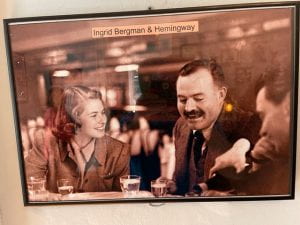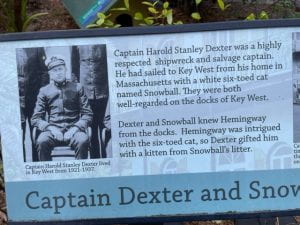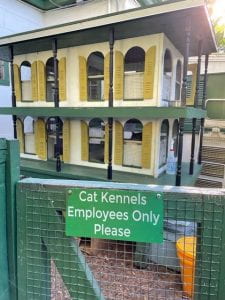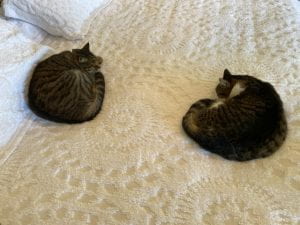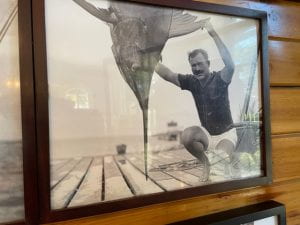The story goes that in 1931 Ernest Hemingway and Pauline lodged temporarily in a Key West apartment, awaiting the delivery of his Model A roadster, but the wait was prolonged enough for him to fall in love with the town. He loved the fishing, the beautiful shoreline, the bars, the intimacy of Key West. Pauline’s uncle bankrolled the purchase of a poorly-maintained house on Whitehead Street, and they worked relentlessly to make it a winter residence.
The famous polydactyl (six-toed) cat was a gift of Captain Harold Dexter. Snowball spawned 59 descendants by best reckoning and they swarm the house today with their own residence and keepers. They have the usual cat presence of belonging to a place and ruling it.
We were interested in the 1930’s story of Ernest Hemingway, since we had just visited Yellowstone where he was known for his hunting and drinking prowess in the summer at the L__T Ranch in Wyoming. While he was writing The Green Hills of Africa in Key West, he was writing Death in the Afternoon and To Have and Have Not between 1932 and 1936 in his northern retreat. Chris Warren, his Yellowstone High Country biographer, claimed he was happiest and most at home with his family during this time in wilderness. He taught his boys to hunt and fish and frequently went hunting with Pauline, who knew her way around a rifle.
A great source on Hemingway’s writing technique, especially in Key West in 1934, is With Hemingway: A Year in Key West and Cuba. compiled from the notes of the hopeful novelist, Arnold Samuelson. He mentored the young writer while he did odd jobs around the homestead and the boat, the Pilar. A good insight into his writing routine:
Never pump yourself dry. Leave a little for the next day. The main thing to know is when to stop. Don’t wait until you’ve written yourself out. When you’re really going good and you come to an interesting place and you know what’s going to happen next, that’s the time to stop. Then leave it alone and don’t think about it; let your subconscious mind do the work. , The next morning, when you’ve had enough sleep and you’re feeling fresh, rewrite what you wrote the day before. When you come to the interesting place and you know what is going to happen next, go on from there and stop at another high point of interest. That way, when you get through, you never get stuck and you make it interesting as you go along. (11)
This explains why Hemingway typically spent the afternoons fishing or hunting without consulting his work. He had a rhythm that energized his work and depended on an active sporting life. We had lunch at one of his favorite haunts : “Blue Heaven.” Nearby he officiated boxing matches at a place called “The Blue Goose.”
Charles Thompson came from an influential Key West family and “taught Hemingway to fish the big water of the Gulf Stream” (High Country, 27). In turn Hemingway showed Thompson around the big game of Yellowstone in 1932. The following year they traveled to Africa to hunt the really big game. They enjoyed a sometimes competitive, sometime ruthless hunting relationship. Much of the experience is found in The Green Hills of Africa.
In With Hemingway, Samuelson relates the fishing on board the 38-foot Pilar, Hemingway’s new fishing boat, in which he travels to Cuba. Pilar was a nickname for Pauline and the heroine in For Whom the Bell Tolls. EH, as Samuelson referred to him, enjoyed helping others hook the marlin and sailfish with him at the helm, as he did landing the fish himself.
The well-known Key West illustrator, Guy Harvey, drew the story of The Old Man and the Sea early in his career, and his illustrations follow the stairs up three flights in the Custom House Museum. The stairs, with their captions and illustrations, are fascinating to climb, considering you can not find the drawings paired with the Hemingway text anywhere else.

